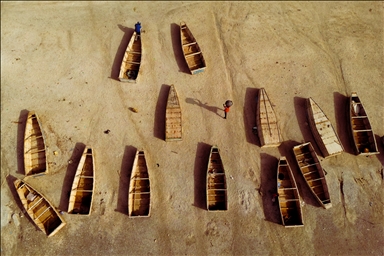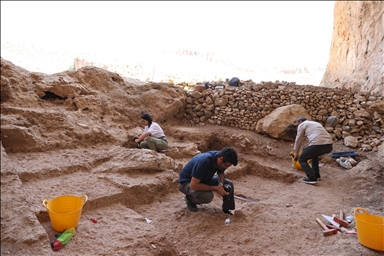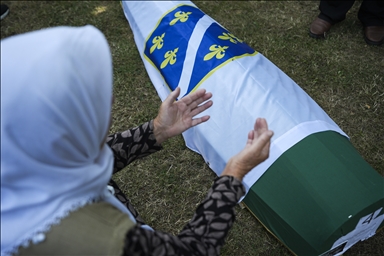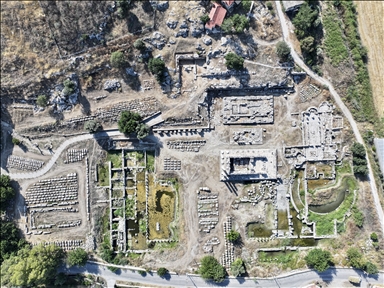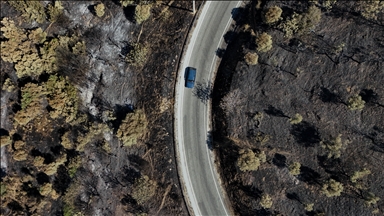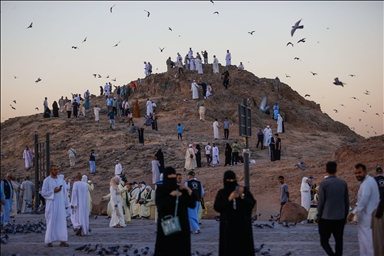
A view from the ancient city of Petra, Jordan on December 15, 2019. The archaeological city of Petra, also known as the rose-red city, marks one million tourists to visit Jordan's archaeological site this year. It is not known exactly when Petra was built, but the city began to prosper as the capital of the Nabatean Empire from the 1st century BC. In addition to the magnificent remains of the Nabatean city, human settlement and land use for over 10,000 years can be traced in Petra, where great natural, cultural, archaeological and geological features merge. ( Aysu Biçer - Anadolu Agency )

A view from the ancient city of Petra, Jordan on December 15, 2019. The archaeological city of Petra, also known as the rose-red city, marks one million tourists to visit Jordan's archaeological site this year. It is not known exactly when Petra was built, but the city began to prosper as the capital of the Nabatean Empire from the 1st century BC. In addition to the magnificent remains of the Nabatean city, human settlement and land use for over 10,000 years can be traced in Petra, where great natural, cultural, archaeological and geological features merge. ( Aysu Biçer - Anadolu Agency )

A view from the ancient city of Petra, Jordan on December 15, 2019. The archaeological city of Petra, also known as the rose-red city, marks one million tourists to visit Jordan's archaeological site this year. It is not known exactly when Petra was built, but the city began to prosper as the capital of the Nabatean Empire from the 1st century BC. In addition to the magnificent remains of the Nabatean city, human settlement and land use for over 10,000 years can be traced in Petra, where great natural, cultural, archaeological and geological features merge. ( Aysu Biçer - Anadolu Agency )

A view from the ancient city of Petra, Jordan on December 15, 2019. The archaeological city of Petra, also known as the rose-red city, marks one million tourists to visit Jordan's archaeological site this year. It is not known exactly when Petra was built, but the city began to prosper as the capital of the Nabatean Empire from the 1st century BC. In addition to the magnificent remains of the Nabatean city, human settlement and land use for over 10,000 years can be traced in Petra, where great natural, cultural, archaeological and geological features merge. ( Aysu Biçer - Anadolu Agency )

A view from the ancient city of Petra, Jordan on December 15, 2019. The archaeological city of Petra, also known as the rose-red city, marks one million tourists to visit Jordan's archaeological site this year. It is not known exactly when Petra was built, but the city began to prosper as the capital of the Nabatean Empire from the 1st century BC. In addition to the magnificent remains of the Nabatean city, human settlement and land use for over 10,000 years can be traced in Petra, where great natural, cultural, archaeological and geological features merge. ( Aysu Biçer - Anadolu Agency )

A view from the ancient city of Petra, Jordan on December 15, 2019. The archaeological city of Petra, also known as the rose-red city, marks one million tourists to visit Jordan's archaeological site this year. It is not known exactly when Petra was built, but the city began to prosper as the capital of the Nabatean Empire from the 1st century BC. In addition to the magnificent remains of the Nabatean city, human settlement and land use for over 10,000 years can be traced in Petra, where great natural, cultural, archaeological and geological features merge. ( Aysu Biçer - Anadolu Agency )

A view from the ancient city of Petra, Jordan on December 15, 2019. The archaeological city of Petra, also known as the rose-red city, marks one million tourists to visit Jordan's archaeological site this year. It is not known exactly when Petra was built, but the city began to prosper as the capital of the Nabatean Empire from the 1st century BC. In addition to the magnificent remains of the Nabatean city, human settlement and land use for over 10,000 years can be traced in Petra, where great natural, cultural, archaeological and geological features merge. ( Aysu Biçer - Anadolu Agency )

A view from the ancient city of Petra, Jordan on December 15, 2019. The archaeological city of Petra, also known as the rose-red city, marks one million tourists to visit Jordan's archaeological site this year. It is not known exactly when Petra was built, but the city began to prosper as the capital of the Nabatean Empire from the 1st century BC. In addition to the magnificent remains of the Nabatean city, human settlement and land use for over 10,000 years can be traced in Petra, where great natural, cultural, archaeological and geological features merge. ( Aysu Biçer - Anadolu Agency )

A view from the ancient city of Petra, Jordan on December 15, 2019. The archaeological city of Petra, also known as the rose-red city, marks one million tourists to visit Jordan's archaeological site this year. It is not known exactly when Petra was built, but the city began to prosper as the capital of the Nabatean Empire from the 1st century BC. In addition to the magnificent remains of the Nabatean city, human settlement and land use for over 10,000 years can be traced in Petra, where great natural, cultural, archaeological and geological features merge. ( Aysu Biçer - Anadolu Agency )

A view from the ancient city of Petra, Jordan on December 15, 2019. The archaeological city of Petra, also known as the rose-red city, marks one million tourists to visit Jordan's archaeological site this year. It is not known exactly when Petra was built, but the city began to prosper as the capital of the Nabatean Empire from the 1st century BC. In addition to the magnificent remains of the Nabatean city, human settlement and land use for over 10,000 years can be traced in Petra, where great natural, cultural, archaeological and geological features merge. ( Aysu Biçer - Anadolu Agency )




